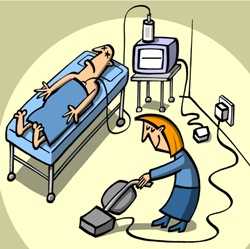0 Volumes
No volumes are associated with this topic
American Medicine Before 1965
New topic 2019-05-25 13:19:03 description
American Medicine Before 1965
New Foreward
In the early 1980s, American hospitals adopted the remarkable concept of being repaid by Medicare and Medicaid on the basis of the patient's diagnosis, instead of itemized bills for the patient services. The system spread to other health insurance companies, and the diagnosis list was greatly simplified. The result was "Diagnosis-Related Groups" or DRG.
I happened to be in the audience at the Congressional hearing considering this proposal and was initially pleased with what seemed to produce a considerable reduction of paperwork and a potential increase in public understanding. Now proven entirely wrong on both predictions, I am in fact appalled by the changes in medical care DRG provoked. However, I must admit it was a brilliant way for the insurance industry to suppress costs of hospital inpatients. Unfortunately, that was just pushing on a balloon, with the costs bulging out elsewhere. These unexpected consequences were even more devastating because it took so long to understand what was causing them.
Whatever the original motives, the DRG paperwork simplification has proven to be primarily a cost control measure. One illustration of this core theme lies in the way the DRG list itself was simplified. Starting from abandoning the Standard Nomenclature of Diseases and Operations(SNODO, a compendium of well over a million diagnoses) and going to the International Classification of Diseases (ICD) of only several thousand, as a basis, "diagnoses" were reduced to the original DRG set of about 250. Right there, was an unrecognized sign that medical science wouldn't play much of a part in it. Presumably, it was easy to set 250 prices, hard to set a million of them. But both the hospital and the insurance company were really only interested in one thing: what was the aggregate amount of the reimbursement. If they could agree on some approximation, all that medical stuff could be skipped.
Refinements of the DRG list now amount to about three hundred different price numbers, one among which could be assigned to each patient with some sort of medical justification, like "all other". Increasingly, diagnoses were assigned to a particular diagnosis group more because of the similarity of their prices than a similarity of their medical content. Increasingly, all bills were considered automatically fair by the auditors if the grand total of hospital payments was unchanged. Just over the horizon can be seen the approach of matching each DRG to some target based on a budget rather than progress in medical care. The purpose was to hold down the prices of hospitalizations through standardizing them; if the hospital received the same amount of money, what difference did it make? The answer to that question is: we always expected future medical progress to change the cost of care, sometimes up, sometimes down. Regardless of national cost problems, we did not expect the payment system to define the direction of medical care, or for the people most concerned with costs to over-rule the judgments of those primarily concerned with the patient, without even talking to them. Mutual respect and compromise -- now, those are different things. Freezing the revenue stream means if you want something new, you have to give something up. For a hospital of all places to exclude the patient's physician from the trade-off is going to lead to something the patient won't like. Making the physician an employee may silence him, but that only makes the medical catastrophe worse when it surfaces. As shown by recent statistics, the overall profit margin on inpatient hospital patients has remained close to 2%. If that is your only measure of success, the DRG seems a success.
However, a simple example casts doubt on the finality of that decision. Payment based on diagnosis means it no longer makes any difference how long a patient remains in the hospital. Such an effect surely raises costs, but since the price is constrained, the extra cost reappears somewhere else. The same is true of laboratory tests, and bandages, and a whole lot of other costs like cleaning people and computer technicians. So now the burden of holding costs downshifts from the insurance to the hospital itself? Plausible, except that isn't what happened.
What happened was hospitals shifted their sources of revenue toward services not covered under DRG, like the Emergency Room and the outpatient area. They bought up doctor's practices and created satellite clinics. Since no one works as hard for a salary as he would work by being paid piecework, we get a doctor shortage. And consequently, the cost of new medical schools has to be added to the indictment. Since the episodic treatment does not cover an entire illness, it is not and never will be suitable for DRG. And since the hospital administration covers both types of services, it opens the business school opportunity to divert costs to the inpatient area and profits to the outpatient area, while paying big administrative costs to the umbrella organization. Getting hard boiled like that translates somewhere into even greater pain for the indigent and uninsured. Emergency services now have a profit margin of 15%, and outpatient areas now return 30%. Administrator salaries are now in seven figures.
But even that isn't so bad as the trick by which it is accomplished. It's called the Chargemaster, and it has the unfortunate byproduct of dumping the highest charges on the patients who can least afford them, the uninsured ones. When you joke about aspirin tablets which cost twenty dollars, see if you can laugh at bills of $300,000 for treating Hodgkin's Disease, the same conditions for which an insurance company pays 10% of the bill for aspirin or Hodgkins. A famous surgeon friend of mine once muttered, "Nowadays the main reason for having health insurance is to keep the hospital from fleecing you."
Medical Tort Reform (1)
The U.S. House of Representatives will soon consider a medical malpractice reform (limiting awards for pain and suffering to $250.000) which it adopted seven times in the last ten years. Following almost certain House passage, the proposal will then confront the Senate,

|
| cartoon malpractice |
where it has failed seven times. The politics of the two chambers are not chief concerns of this paper, which strongly advocates passage. The paper contends that unwise incentives for patients to bring suit are important causes of present difficulty, and reducing such incentives offers a comparatively simple opportunity to bring the complex issue to quick stability. Stability is essential before more sweeping changes can be examined. The collection of data in certain areas would reduce the scope for vituperation and ideology, another important step toward a solution. Full recognition must eventually be given to the intertwined complexity of industrial product liability, the McCarran Ferguson Act, hospital and corporate governance in general, the tort system, pass-through of Medicare and Medicaid overhead reimbursement to malpractice premiums, even universal health insurance. Some small step must begin such an interlocked rearrangement, and a cap on pain and suffering has the major advantage of being successfully tested by twenty-five years of experience in California and Indiana.
This paper makes no claim of identifying all the root causes or predicting all the calamitous consequences of inaction. Advocating passage of national laws to reduce plaintiff incentive to sue, it chiefly focuses on the chief arguments historically made against the present proposal, offers some comparatively novel insights in favor, and makes suggestions for collecting data to reduce the latitude for disagreement.
Congress will again take up malpractice tort reform (MICRA) in 2005. perhaps successfully. The 2004 outcome was close. Since the Republicans subsequently made electoral gains in both House and Senate, the leadership is considered likely to re-introduce the same bill and try to hammer it through. The bill's medical essence is to limit awards for "pain and suffering" to $250,000, contrasting strongly with recent escalating awards which have sometimes reached $100 million. Newcomers to the issue may be surprised that so much emphasis gets placed on this point, but thirty years of wrangling experiences in state legislatures have produced this reform alone with proven effectiveness. In the course and semi-jocular language of politics, "nothing helps the malpractice problem unless it involves on
Malpractice: State or Federal Problem?

|
| McCarran Ferguson Act |
The 1945 McCarran Ferguson Act prohibited federal agencies from regulating the business of insurance whenever individual states had passed laws on the topic. However, Congress can always modify its own laws, so McCarran Ferguson is not a serious obstacle to a federal tort reform law. Legislative interference in the judicial branch is admittedly somewhat more sensitive, particularly if the U.S. Supreme Court resists. However, the Supreme Court would have to be feeling especially prickly to block Congressional action whose effect is to increase the authority of the federal over the state courts, particularly in circumstances where the state courts appear to be failing.
Proponents of tort reform, the American Medical Association in particular, very much prefer one federal law to fifty state reform laws. Not only does it simplify the scrambling around, but the federal Congress is likely to be more sympathetic to this particular issue. Sixty years of state politics have saturated the various state legislatures with trial lawyers, building up a formidable example of conflict of interest. After all, since 1937 the legislatures have had comparatively little to occupy their attention except insurance. At one point, the Pennsylvania legislature found itself with the speaker, vice speaker, majority leader, and chairmen of both judicial committees all trial lawyers.

|
| Bill Frist |
And then there are personal circumstances of leadership. The U.S. Senate Majority Leader in 2005 was William Frist, M.D., a distinguished cardiac surgeon. Cardiac surgery is one of the specialties with the highest risk of a lawsuit, and the highest malpractice insurance premiums. His predecessor, Robert Dole, had been openly critical of the trial lawyers as a factor in Senate politics, an attitude that seems to come with the job. For balance, the 2004 President of the AMA, Donald Palmisano, M.D. was a lawyer.
Back of this line-up is the history that a cap on pain and suffering had been passed by the U.S. House of Representatives seven times in the last ten years (only to fail in the Senate), and most of the supporters are still in office. Proponents of tort reform, and opponents too, regard the matter as a foregone conclusion in the House. It's the Senate where it will be decided, requiring 60 votes to overcome a filibuster. Meanwhile, President George Bush, a notably vigorous political partisan, has announced early support. From the Republican point of view, trouncing the trial lawyers would be a delicious thing, but both sides must be wary of public annoyance at partisan behavior.
So, what about Constitutional issues? There really can be no argument about the jurisdiction for tort cases; they are tried in state courts, and no one proposes shifting to federal court. The Ninth and Tenth Amendments, plus two centuries of tradition place tort cases within state courts. The states have seemingly made a mess of the matter, but nevertheless, we are surely going to hear a lot about states rights when this matter comes up in the Senate. Justices Rehnquist and O'Connor have historically been strong advocates of states rights.
The strongest argument for a federal solution, in Congress or in the Supreme Court, lies in the discordance between states repeatedly imposed by individual state constitutions. In this area, the trial lawyer lobby might have over-reached. It can be terribly difficult to amend a state constitution, sometimes requiring super-majorities of both legislative houses in two successive years. When one faction achieves a brief but overwhelming dominance it can sometimes pass constitutional amendments that are very difficult to overturn even when the political climate significantly changes. The consequence: it is comparatively easy to pass tort reform laws in some states, next to impossible to do so in others. Add to that the matter of interpretation of these constitutions by state supreme courts that are often strongly partisan, and you can have a highly inequitable inter-state situation that is nearly impossible to change. One of the main functions of the U.S. Supreme Court is to settle conflicts between jurisdictions. When some states have firm limitations on non-economic awards, while other states effectively prohibit legislation on the subject, it is time to look at a national solution if we are to remain a single nation.
Malpractice: Reported Medical Errors

|
| Wall Street Journal Errors |
A recent article in the Wall Street Journal reports the state of Minnesota releasing a survey of 378,544 surgeries performed in the hospitals of that state in a 15-month period. During that time, 99 serious medical errors were found, 21 of which resulted in the death of the patient. One error in about four thousand surgeries, and one death in twenty thousand. Because of an understandable reluctance to self-report mistakes, assume this incidence of negligent errors is a bare minimum level of the true incidence. But arbitrarily doubling that to a rate of one death in ten thousand, would be a safety record that calls the malpractice crisis to account. Minnesota is somewhat special, to be sure, frequently held out as demonstrating the lowest medical costs in the country. So go on, then, say the rest of the country has one death in five thousand surgeries. You might be very risk-averse to feel such an incidence warrants destroying our present medical system, imposing some new one with unknowable risk content. That's especially true if you recognize that average American life expectancy got four months longer during those fifteen months. One way to reduce the number of errors would be to perform fewer surgeries, but there are ways of measuring the harm that would do. It's not ever comfortable to defend any error, but it really is necessary to examine the full consequences of any proposal about them.
Let's extend these examples. Since there were only five fatal medication errors in 400,000 Minnesota surgeries, then fatal medication errors must be impossibly rare. An event that only occurs once in eighty thousand cases must represent very special circumstances when it does happen. If people are of the mindset to take 79,000 successful surgeries for granted while applying the most pejorative scrutiny to one case that was unusual, there is no way statistics can change a mindset that the medical system is riddled with error.
My own reaction to these bare statistics is that if there really was only one death from a medication error, there must have been five hundred near-misses. I would conjecture the persons making these mistakes probably caught them before they got serious most of the time, perhaps four hundred times. And then one or two other people caught it most of the rest of the time, leaving the last few cases to escape by pure luck, and one unlucky person making it through to the statistical report. Over a period of two centuries, the hospital has developed systems for catching errors, and most of the systems depend on redundancy. We in hospitals do almost everything three times, screening out a huge amount of human error under stress. Any efficiency expert worth his stop-watch can see repetition and overlap, redundancy, and\waste. Focused factories, as Professor Herzlinger of Harvard styles them, can easily save money by enforcing a discipline of doing it once, and doing it right the first time. That saves money, and that's not a minor issue. But if we yield too far to this pressure, some of those other five hundred medication errors are likely to prove fatal.
A modern hospital employs several thousand employees, of varying levels of skill and training, with a great deal of employee turnover. An occasional incorrigibly incompetent employee can occasionally do real damage before being identified and dismissed. In recent years professional shortages in critical areas can force some substandard employees to be tolerated longer than they should be. By encouraging longer stretches of employment, a congenial slow-paced environment can reduce the incidence of errors but then look out for those efficiency experts. And crowded, tense anthills of activity must perform all day and all night, weekends and holidays. Emergencies appear out of nowhere, the door to the ambulance entrance banging open to a cluster of shouting excited firemen. They can appear at a moment when every single employee is lashed to a heaving deck of other necessities, or wearily starting out the door at the end of a tumultuous day. Some other pious professor or earnest newspaper columnist offers the non-helpful suggestion that we would perform better if we got more rest. What suggestions might be valuable to reduce stress when the loudspeaker blares, Code Blue?
Malpractice: Insurance War Stories

|
| ROBERTS |
The 1937 Supreme Court (Owen Roberts, for the majority) allowed Franklin Roosevelt's New Deal to place the federal government in charge of all American commerce, not merely interstate commerce as the "commerce" clause of the Constitution provides. Congress, however, soon exempted the insurance industry from that federal control by passing the McCarran Ferguson Act. States were thus put back in charge of insurance, and it's about the only commerce they are in charge of. Out of this peculiar political anomaly, grows the present uncomfortably deep penetration of the local insurance industry into state politics. And over time, the unanticipated deep penetration of state politics into insurance.
In return, state governments have conferred at least one favor on insurance lobbyists unwisely. If an insurance company fails, subscribers angrily find themselves stranded. The patchwork solution arises, of assigning the obligations of a failed company to its surviving competitors. With no immediately visible cost to the taxpayers, that seems to rescue the subscribers. But it removes any point to competition, eventually raises premium prices, and overall, broadcasts moral hazard. That is, it doesn't matter how badly they behave, their competitors will have to pay for their mistakes. Moral hazard is the most insidious form of political corruption because it is so seldom punished.
Politically inclined state insurance commissioners have other favors to extend. Malpractice companies work in an environment with a peculiarly long tail. (Translation: It's at least six years before the average case is finally settled and paid.) A brand new insurance company collects premiums for six years before paying out much for claims. True, with unrealistically low premiums they are destined to go bust in six years, but there's a free ride in the meantime, including an available punt in the stock market with unspent cash. Investment income during those six years is chancy, making survival a gamble after six years. Lately, the true finances can be obscured by "finite reinsurance", which guarantees to absorb heavy losses, but often neglects to announce how briefly it will do so. It's the job of the Insurance Commissioner to decide whether premiums are realistic, the job of the auditors to assure that the complexities are transparent, the job of the competitors to complain if premiums are too low, and the moral hazard for the Insurance Commissioner arises -- from knowing in the worst case it won't matter to the subscribers, the competitors will bear the cost. Since Insurance Commissioners are usually politically appointed young lawyers, competing insurance companies are actually in political competition, not economic competition. As we say in Pennsylvania, you must Pay To Play.
These seamy realities can unexpectedly exploit premium differentials between medical specialties. There are a lot of lawsuits against obstetricians, neurosurgeons, and orthopedists; consequently, the premiums for these specialties are quite high. Pediatricians and general practitioners have low premiums reflecting infrequent lawsuits. Now, it might be supposed a company seeking long-term profitability would prefer to ensure clients who don't get sued. But here and there you can be surprised to see a new company with great eagerness for high-risk clients, people who get sued a lot. This paradox rests on the quick accumulation of big-ticket premiums from a mere handful of clients. Competitors are prompted to suspect companies with that behavior are looking to accumulate as much premium revenue as possible during a six-year free ride, even lowering premiums somewhat to generate business. But if they misjudge the stock market during those six years, all the other competing companies will likely be forced to pay for the gamble.
Once in a while, the totally unexpected happens. For example, some years ago thirteen judges in one city went to jail for accepting bribes. The Republicans wouldn't appoint Democrat judges, and the Democrats wouldn't confirm Republican appointees to fill the vacancies. During this impasse, Congress happened to pass a law leap-frogging drug offender cases ahead of everything else on court dockets; the unanticipated consequence was an eight-year period without malpractice trials. It became a sort of judicial coiled spring. Insurance companies accumulated huge reserves, the politicians squeezed down the excessive premiums as "windfall profits", money was made and lost in the stock market, and when finally the judicial logjam was broken, the cases had to be paid. Guess what. There wasn't enough money to pay the claims, and premiums took a big jump. Doctors and lawyers bellowed at each other that it was the other profession's fault. In a sense, that wasn't fair either way, although come to think of it, most judges are lawyers. As are most legislators. And Insurance Commissioners. These particular lawyers may not have participated in the problem, but only they are in a position to fix it.
Malpractice: Captain of the Ship ... New Title, One Step At A Time, but A Big One.
 One important step is reducing the financial incentives for plaintiffs to sue 
|
| Dr. Fisher |
In a situation as complex as the medical malpractice crisis, it's hard to know where to begin, and how far to go. We argue here for reducing the financial incentives for plaintiff's to sue. Of the various steps which would accomplish that, the one with proven effectiveness is to place an upper limit of $250,000 on awards for non-economic damages, mainly pain, and suffering. Another step which is easy to explain is to allow juries to know about (and take into consideration) the economic damages which have already been paid by another insurance, like Blue Cross or Worker's Compensation. A third world is to pay out damages for support and disability month by month instead of in a big lump sum which may never be used. These financially-oriented changes, particularly the cap on pain and suffering awards, would be sufficient to stabilize the present chaotic situation for perhaps as long as ten years. During that period of respite, more basic reforms could be examined and tested. It would definitely be better not to get into many of the fundamental issues, just now.
-- The present tort system is said to have been invented by Charlemagne in the 8th Century, to put a stop to a private settlement of disputes by duels and revenge fights. It has evolved into a system which attempts to place a dollar value on every injury and compensate the injured party. It must be obvious that some injuries do not have any equivalent in dollars, and few injuries are much improved by being paid for. Society needs a long period of reexamination of how we can best compensate those who would benefit from financial compensation, and then what to do about problems that money will not solve. We need a new system that is less expensive to operate, gets better results quicker and has less tendency to provoke dissention. To do that well, will first require at least ten years of stability, not likely unless we do something first to stabilize.
-- Too many other issues are crowding the attention of our legislators. A related issue, product liability, has greater power to gain attention, regardless of its relative merit. Our medical leaders need to acknowledge that product liability reforms may get ahead of medical malpractice in the Congress if we dither, and therefore sweeping medical reform proposals will then require appreciable modification before they can pass.
-- Similarly, the public is presently dismayed to see the governance of major corporations needs fundamental reappraisal, along with difficult decisions about accounting methods within businesses in general. It is not sensible to respond drastically to the disruptions of hospital governance caused by malpractice-induced upheavals when there looms ahead some unknowable organizational rearrangement of corporations in general.
-- What is being proposed as a simple stop-gap -- is to make a change in the court system, in order to rescue a different profession, the insurance system. Never mind that the courts provoked this problem in the first place, courts will nonetheless prefer insurance to seek an insurance solution to its difficulties. Furthermore, it is a federal approach to what has traditionally been a state matter, both in trials of a tort, and in the business of insurance. Such an approach is not easy to accomplish and must contend with every competitive proposal made by those who would lose from it. All of the alternatives have already been examined and are truly not feasible, but they must have a hearing. Ultimately, it may require political brute force to pass this simple measure, and that has a political cost to be considered.
-- Once the public fully realizes that this problem has a lot to do with rising levels of health insurance and that universal health insurance would thoroughly confound its solution, many people will have to reconsider their deeply-held opinions. The steps taken to stabilize this situation must be simple, easily understood, and adopted soon. There is more to be said, but it's better to stick with a simple point, and adopt a solution that can demonstrate twenty-five years of success in several states.
To summarize the present medical malpractice snarl, particularly what the 2005 Congress should do about fixing it, please tolerate first a bit of naval history from 1777. Speculative Philadelphians rowed across the Delaware River to New Jersey and as far up the Jersey creeks as they could go. Walking a mile or so East, they reached the bustling shipyards of privateer captains, at the headwaters of creeks running the other way, out to sea. The speculators bought shares in the vessels of likely-looking captains, their money bought supplies and sign-on inducements for the crew. The captains then sailed out to blue water through the coastal creeks and bays, and if they came back, paid off the shareholders. If they never came back, the shareholders lost their money, the sailors including the captain lost their lives. When ships were lost, it was presumed to be the captain's fault, but he risked his own life in the process, so utmost diligence in a chancy business was fairly confidently presumed. That's the way the "captain-of-the-ship" idea evolved when corporations, especially hospitals, emerged in the following century. And that's the origin of the belief that the responsibility of the stockholder was limited to his investment, and supervision of the captain was very limited. As business corporations evolved out of this model, the stockholders took some responsibility, and the captain-like C.E.O. took considerably less personal responsibility for mistakes of employees doing what they were told to do. Eventually, stockholders were assigned the whole cost of corporate damage awards, gaining very little true control in the process. Hospitals, possessing charitable immunity, were just about the last to go down this trail, so many principles of the captain of the ship idea persisted, both confounding the hospital-physician relationship in court, and the mutual rights and responsibilities in actual medical care delivery, when charitable immunity was suddenly withdrawn. Using every argument weak and strong, and exploiting every legal ambiguity, the trial bar then unwittingly brought this disruption of essential services to the point where something absolutely must be done about it, and soon.
Unfortunately, redesigning responsibilities in the whole corporate structure of America is too heavy a topic for this spring's debate on medical malpractice. We're certainly moving in some direction, with criminal lawsuits now in the process personally against the C.E.O.s of some of our largest corporations for transgressions that may not be medical, but nevertheless, leave undigested implications from the recent Sarbanes-Oxley Act concerning for-profit corporate governance. No one is willing to permit so unique a corporation as a hospital undoubtedly is, to establish principles of law governing the entire economy. Herein lies one of the main arguments in favor of stop-gap legislation, rather than get-to-the root-of-it legislative statesmanship about MICRA, or whatever we call medical malpractice legislation on a federal level.
The second argument for a patchwork solution lies in the vexing entanglement of the medical malpractice crisis with other inflammatory national medical questions: what should we do about employer-based third-party health insurance or even health insurance in general? The wounds are too sore from the 1993 Clinton proposal, and from the subsequent managed-care fiasco, or the more recent prescription drug tangle, for there to be any hope of keeping those echoes out of a medical malpractice debate. Employers are deeply involved in product liability questions at the same time they are heavily invested in employee health insurance. If we force them to choose between their conflicting interests in these two areas, they may decide the net balance of their Washington interests favors a course of action on medical malpractice which makes the malpractice crisis worse. Notice that malpractice awards are pretty much confined within the limits of malpractice insurance, with a major role of moral hazard making things worse. Malpractice insurance, particularly the hospital part, is almost entirely financed out of health insurance. And rising costs of malpractice awards are thus a major source of rising malpractice insurance premium rates while rising malpractice premiums put upward pressure on health insurance premiums. Round and round it goes, making it impossible to establish a new theory of one form of insurance without a new theory of managing the other one. The situation cries out for a workable stopgap, followed by a period of calm rumination.
A number of earnest proposals have been made in the last forty years, and almost none of them has had any effect. The defense bar, putting forth a succession of obscure legal doctrines to make it easier to defend cases, has not been a productive source of ideas. Since only a small proportion of very similar medical mishaps trigger a lawsuit, all those well-meant ideas for arbitration or alternative dispute resolution raise the specter of creating a staggeringly huge entitlement for a particular sort of injury. Carry that further to all injuries caused by anybody, and you can't tell where you would be going, but you know for certain it would be more expensive than even the present crazy system.
In all the wrangling and experimentation about medical malpractice which has been going on for two generations, only one general approach has been demonstrated to work quickly and surely: reduce the financial incentives of plaintiffs and their representatives. California and Indiana provide twenty-year demonstration projects on the consequences of placing a $250,000 cap on non-economic damages, generally known as awards for pain and suffering. Legislation which includes a provision that juries be told that health insurance has already paid for injury repair (repealing the Collateral Source Rule) or that a widower has since remarried and does not need supplementary child care, or similar circumstances, would probably get attached to such legislation without great debate. Structured (rather than lump-sum) payment of damages is another legal term for reform of a "money issue" which would probably pass any session of Congress willing to pass a cap on pain and suffering.
So let's get on with it. Put a reasonable cap on pain and suffering, attach a few other legal obscurities, and bring this malpractice issue to a screeching halt. And then, in the ten or twenty years of respite, it would provide, thrash out all those fundamental questions of corporate governance and responsibility, of non-adversarial dispute resolution, of party politics, and universal health insurance. There's a fair chance those questions can never be satisfactorily resolved. But even if they can be, this malpractice matter won't allow you to wait for it.
7 Blogs
American Medicine Before 1965
New blog 2019-05-25 00:50:26 description
New Foreward
Why are hospital prices so high?
Medical Tort Reform (1)
 Executive Summary.
Executive Summary.
Malpractice: State or Federal Problem?
 It would be lots easier to solve the malpractice problem if it could be all concentrated in one federal place.
It would be lots easier to solve the malpractice problem if it could be all concentrated in one federal place.
Malpractice: Reported Medical Errors
 It
It
Malpractice: Insurance War Stories
 It takes as long as six years from the time of a malpractice incident, to the time an award is paid for it. Manipulated finances in the meantime generate lots of problems.
It takes as long as six years from the time of a malpractice incident, to the time an award is paid for it. Manipulated finances in the meantime generate lots of problems.
Malpractice: Captain of the Ship ... New Title, One Step At A Time, but A Big One.
 The medical system has become so complex that it
The medical system has become so complex that it